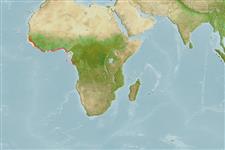Élasmobranches (requins et raies) (sharks and rays) >
Carcharhiniformes (Ground sharks) >
Sphyrnidae (Hammerhead, bonnethead, or scoophead sharks)
Etymology: Sphyrna: Probable misspelling of sphyra (Gr.), hammer, referring to their hammer-shaped heads (See ETYFish).
Eponymy: Monsieur Couard was Director of shark fisheries off the coast of Senegal, the type locality. Unfortunately we can find nothing more about him. (Ref. 128868), visit book page.
Issue
Junior synonym of Sphyrna lewini (Griffith & Smith 1834) in Ref. 94083,106604. This page will be deleted.
Environment: milieu / climate zone / profondeur / distribution range
Écologie
marin benthopélagique. Tropical; 17°N - 5°S, 19°W - 13°E
Eastern Atlantic: Senegal to Congo. Not in Compagno's 1999 checklist (Ref. 35766).
Taille / Poids / Âge
Maturité: Lm ? range ? - ? cm
Max length : 300 cm TL mâle / non sexé; (Ref. 244)
A coastal-pelagic shark. Feeds on fishes, especially bony fishes, and also benthic and epibenthic cephalopods. Viviparous, with 24 to 28 young in a litter. Size at birth about 30 to 32 cm.
Life cycle and mating behavior
Maturité | Reproduction | Frai | Œufs | Fécondité | Larves
Viviparous, placental (Ref. 50449).
Compagno, L.J.V., 1984. FAO Species Catalogue. Vol. 4. Sharks of the world. An annotated and illustrated catalogue of shark species known to date. Part 2 - Carcharhiniformes. FAO Fish. Synop. 125(4/2):251-655. Rome: FAO. (Ref. 244)
Statut dans la liste rouge de l'IUCN (Ref. 130435: Version 2025-1)
Menace pour l'homme
Traumatogenic
Utilisations par l'homme
Pêcheries: pêcheries vivrières
Outils
Articles particuliers
Télécharger en XML
Sources Internet
Estimates based on models
Preferred temperature (Réf.
123201): 24.4 - 28, mean 26.7 °C (based on 64 cells).
Phylogenetic diversity index (Réf.
82804): PD
50 = 0.5006 [Uniqueness, from 0.5 = low to 2.0 = high].
Bayesian length-weight: a=0.00347 (0.00153 - 0.00788), b=3.12 (2.93 - 3.31), in cm total length, based on LWR estimates for this (Sub)family-body shape (Ref.
93245).
Niveau trophique (Réf.
69278): 4.5 ±0.54 se; based on food items.
Résilience (Réf.
120179): Faible, temps minimum de doublement de population : 4,5 à 14 années (Fec=24).
Fishing Vulnerability (Ref.
59153): Very high vulnerability (90 of 100).
🛈
